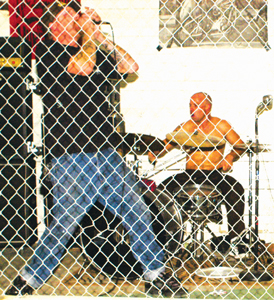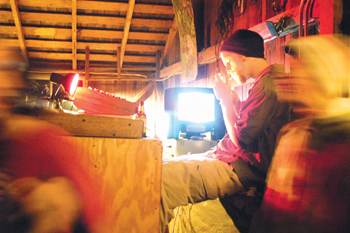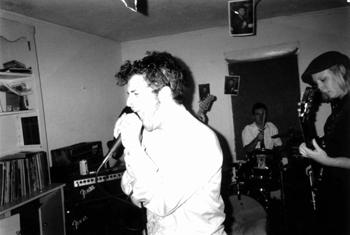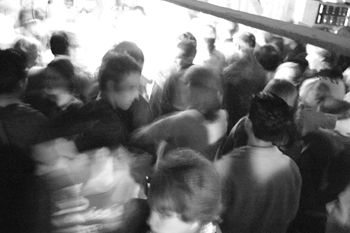![[Metroactive Music]](/music/gifs/music468.gif)
[ Music Index | Santa Cruz Week | SantaCruz Home | Archives ]
The Underground Scene Is Murder: The Highway Murderers use their industrial-looking setup for house shows and rehearsals.
House Rules
A dedicated group of music lovers have taken matters into their own hands to save the underground Santa Cruz music scene. Armed with nothing but a willingness to let strangers into their homes and a muffling mattress or two, house shows are opening their doors to music for the masses.
By Mike Connor
Granted, house shows have been happening since the first cave people pounded on cave walls with cave rocks. These days, though, most of us look to established music venues for our live music. But as profit-driven ventures with a myriad of expenses to cover, most venues and promoters book touring acts or local bands that already have an established following in their community. In this system, lesser-known bands--and sometimes entire genres of music--are left in the lurch.
Enter the house shows, which are proliferating in minicircuits all over the country, and have long thrived here in Santa Cruz. In part, their very existence is a do-it-yourself snub to the increasingly corporate structure of the music world, where the cookie-cutter band is king. House shows are a relatively cheap way to support obscure, challenging or otherwise underground music in an intimate setting. And they're particularly popular here on the West Coast, where the long expanses between big cities cry out for some heroic host along the way to bring touring bands into their homes. Locally, a steady decline in the number of alternative and all-ages venues has inspired music lovers to open up their homes to the masses in a constant effort to keep the underground music scene alive.
To a lot of folks, the very thought of it is insane. People let bands play music in their homes, and then invite complete strangers to come see the show? Aren't they worried about their silverware? What if someone spills Mad Dog on the sofa?
And it's true, anyone who put on a house show has to deal with these issues on some level, because shit happens. They have to figure out how to keep the noise level down. While acoustic Celtic and folk shows don't make much noise to begin with, amplified rock shows do--and they're illegal. There's a long tradition of friction between live music venues and the authorities--as the successful Blue Lagoon lawsuit shows, even "legit venues" have to deal with plenty of hassling from the police. Some people have houses that are secluded enough that nobody knows a show is going on; others simply cram mattresses over their windows and keep the doors shut.
In short, they come up with whatever creative solutions they can to keep the noise and damages down. And while it may seem like a big pain in the ass to pull it all off, it's a labor of love for the people who put these shows together. For one, they're directly participating in the cultural enrichment of their town. Plus, they get to hang out with cool musicians, and see what they look like with bedhead the next morning. And if the hosts have their own band and want to rock the fucking house down, well, they know at least one place that will have them.
Secret Agents of Art: One of the key players on the house show scene mans the sound setup at a local spot that shall remain nameless. That's how these things go.
Roadhouse Murderers
Of all the illegit venues in town, one stands out as the biggest, the rowdiest and the loudest. The inside of this faceless building is gutted and usually filled with souped-up cars and various automotive innards. But when it's time for the Highway Murderers to put on a show, the whole place is emptied out. Only a fenced-in stage, a skateboard ramp and some random junk and couches remain. Kids come out to drink, skate and mosh the night away--over 300 people showed up for their last party. With no neighbors in an industrial part of town, it's a party thrower's dream.
The place is controlled by the Murderers, a faceless mob of raging punk rockers who've been making a name for themselves with reckless shows at the Mediterranean. The band keeps their identity a mystery, refusing to be interviewed on the record, and referring all questions to their spiritual horse and voice beast, a man named Jason Jesse. He owns a motorcycle and machine shop in Watsonville called Automodown, where the Murderers got their start.
Through Jesse, I learn that the Murderers originally got together to fill in the void where all the "sissy la-la bands" out there are playing metal "like it's a bad fucking joke." Their live show is intimidating to say the least--with songs like "Easy Deal" and "Kicking Fucking Ass," the Murderers get straight to the point, and the mosh pit quickly becomes a dangerous place to be. During a recent show at the Med, I watched one guy get kicked in the balls and another walk away bleeding from the head as people fell all over each other in the pit. Even still, there wasn't a single injury or fight at their last party.
"People just want to have a good time," explains Jesse. "As long as we do it without alcohol, and with skateboarding and music, I think we can have a lot of fun."
And they plan to bring their favorite bands along for the ride. Keep an ear to the ground for those shows.
All-Ages Paradise
In a subculture that doesn't ever see the big bucks, band networking and booking reciprocity seems to be a key factor in selecting bands, second only to rabid fandom, which of course is the main reason people put on a house show.
Another is the lack of all-ages venues in town--in Santa Cruz, we've basically got the Teen Center, the 418 Project, 120 Union and sometimes the Catalyst. Hence the emergence of the underground art rock community--easily the most active and populous faction of the house show guerrillas.
Ever since Calvin Johnson and his merry band of K Records bands exploded the teenage underground in the '80s, scenes have cropped up all over the country, and Santa Cruz is no exception. An estimation of the actual number of art/indie rock venues might raise the wrong eyebrows at the police department, so let's just say that if you had a million dollars for every such venue, you'd be totally filthy rich. Anyway there are enough to host dozens of local bands and lots of touring bands besides, fostering a local underground music scene lively and both stylistically and demographically diverse.
"This town doesn't really have a place besides bars that bands can play," says John of Loyal Sons and Daughters, "and that automatically excludes a pretty significant group of people who are interested in music."
Greg Lisher, guitarist for Camper Van Beethoven, remembers the glory days of the '80s, when all-ages venues abounded: UCSC shows like Screaming Jay Hawkins opening up for Fishbone; End of the World parties at Porter and gigs at Sluggo's; the Butthole Surfers and the Red Hot Chili Peppers at the 418 Project when it was Club Culture; Firehose at the Almar Grill when it was another little all-ages club called Diane's. He'd never heard of a house show outside of the keggers with bands.
To be sure, a house show is not usually just a kegger with a band. Most are more about the music than the party. At best, the barriers between audience and performer break down, creating an immediacy of experience that slices through all the layers of insular expectations and preconceived notions of what's good and what's cool, cutting to that level where what the band does and how the audience responds melt together into a tightly energized circuit. In short, it's like a good old-fashioned revival.
"This band called the Quails, they were opening for Sleater Kinney in San Francisco, and I didn't really get it," says John, who also hosts shows in the cramped little living room in his house, an indie rock haven known as the Cube. "But later I saw them at [a house in SC] with Erase Errata, and it was so incredible. People are crowd surfing and doing back flips on the ceiling. I had never really seen anything like that, people totally losing their minds and not being self-conscious about it. I feel like when you go see music, ideally, it can be this intensely cathartic, religious experience. I want people to watch bands and just go insane ... but then come back to earth and realize that you're still in my house, that it's not time for total anarchy right then--maybe wait till you get outside."
He's smiling, but he's more than half serious. Because as much as he hates to admit it, the Cube won't host hardcore punk rock shows anymore, after an incident involving some fashionista punk rock kids who thought anarchy means that you litter, vomit and destroy someone's family photographs.
"We're not 'The Man'," points out Stacey, who helps out at the Cube, but also hosts shows at her own house, oftentimes making the fliers for both venues. "Their graffiti wasn't even intelligent, and had no style."
Stylish fliers are just one of the many perks provided by the art rock community. Says John, "It's pretty satisfying to see all these tour fliers that aren't aesthetically pleasant, and then I'll put up a badass Stacey flier and I feel like a gangster, you know? Like, turf wars."
Thankfully he's joking. But there is a real element of danger publicizing these shows, since amplified music is illegal without a permit. Most of the people I talked to said that the police are rarely an issue. Michelle and Chris explain that preventative measures usually keep the complaints down. Still, they have to be careful about the word getting out, which can look like intentional exclusion from those on the outside looking in.
"I feel really bad about people getting excluded because they can't find an 'in,'" says Stacey, "but it's only because what we're doing is illegal. Like I can't just yell out across the street for weed."
That's not to say that she smokes; it's just an example, but one that might reinforce a negative stereotype about young people hanging out together.
"Whenever there's not a lot of money at stake, people get skeptical that there's some kind of ill intention," muses John. "Forget about the days when people used to get together with their grandparents to husk corn. Nowadays it's like, kids are getting together, nobody's got a lot of money ... so they must all be on drugs. Or they're going to take over the government, which is kinda true," he says, trailing off, "It all makes sense now ... "
Sitting at Cafe Pergolesi during the interview, John, Stacey and I are repeatedly interrupted by people passing by who are either curious about upcoming shows or interested in putting one on. I feel like I'm sitting with celebrities, but John and Stacey just see it as a perk of living in a small town with a tight-knit music community.
"The fact that the town is so small is convenient," says John. "You can walk downtown and run into five people that you know. Like, 'Oh, I want to talk to this person about doing music, or an art project,' and they work at the pizza place across the street, it's not like driving across the city to meet up with your friend. It's a pretty ideal environment to be creative."
Indeed, some might say that the indie rock scene is close-knit to a fault, bordering on--or falling headlong into--being snobbishly insular. Ever the astute sociologist, John explains away this perception in terms of the s-word: shyness.
"I think some people are intimidated to go to house shows," says John, "which I don't fully understand because people aren't intimidated to go to a party, but there's something about the music scene that seems unfriendly or exclusive by people who aren't into it. When I moved to Santa Cruz and was going to small indie rock shows, it seemed like people were aloof and unfriendly, but after getting to know them I just realized they were shy. I feel like the image of unfriendly indie rockers who aren't accepting of anything is concocted; when you're shy and other people are shy, it's hard to bridge that gap. It's unfortunate, because I think there are people making really exciting music, and there's just not really a lot of broad support for that."
Celtic Bliss
Far from the screaming chaos of Chez Murder or the artsy, lo-fi experiments of the indie rock scene, Pete and Linda Hollins are enjoying their retirement in a spacious, sunlit house nestled in the hills above Soquel. The couple hosts about one show a month, providing the use of their home to the Monterey Bay Celtic Society. The vaulted ceilings in their living room make for great acoustics, and a balcony above affords a splendid view of the proceedings when a show gets too crowded downstairs. They've handled as many as 70 people in their home at a time, but shows usually hover in the 30-person range.
As is often the case, a foreigner's perspective makes our culture seem more interesting, and the couple says that they enjoy participating in what they perceive to be a uniquely American cultural oddity.
"House concerts seem to be an American thing," says Pete, who also plays guitar and bazouki for the local Celtic band Molly's Revenge. "A lot of people we get here are Irish and Scottish, and they just love it. They just don't do [house concerts] in Britain. In England, there's a lot of folk-type places that just let people set up in a little room in back, and they'll just sell a few more beers than they normally would. That's kind of the equivalent over there."
Ever the consummate hosts, Linda prepares snacks for the audience and the Hollins usually put up the performers for the night.
"It's like a bed and breakfast that you don't pay for," says Linda with a smile.
Pete relishes the idea that his walls are soaking up the sounds of music, and also looks forward to the day that he can call in favors from visiting artists when his band tours around the U.K.
Gross Incoming: Santa Cruz's Gross Gang tears it up at the Cube.
Folk Yourself
Longtime local Jeff Emery started hosting shows in conjunction with the Camp California concert series, which brought artists like Dar Williams before she broke. They would pick artists from folk festivals, folk conferences and, of course, the radio. Emery says the series fizzled when they lost their critical mass of venues, but he's still hosting shows in his house, which has the rare distinction of actually being designed with shows in mind, so it has great acoustics and plenty of room for seating and is located at the end of a street far from the nearest neighbor.
Emery attributes some of the continuing success of the lesser-known bands performing at his house to the SC radio stations, who help out by programming artists who are on their way into town.
"I think one thing that really makes it work is the public radio we have," says Emery "KUSP, KZSC, and KKUP to some extent. And KPIG--John Sandidge will book anybody that I book on the Sunday shows if the timing works."
He also chalks some of the success up to a solid core of regulars, but insists that "success" isn't measured in dollars, and that the potential to bring in more money by selling alcohol isn't an option at all."
"I make alcohol for a living," says Emery, a Santa Cruz mountain wine grower, "but I don't sell it at the concerts. I heard of a series of piano concerts that got shut down by the ATF because they were selling alcohol."
Tax dollars well-spent, of course. But hopefully, after all the stress these people power through to put on a show, they'll earn a front row seat at the great House Show in the Sky. In the meantime, though, there are earthly rewards.
"The side benefit of this is that the performers are such great people," says Emery, beaming. "Sometimes they stay with us for days, and it's gotten to where I feel like I have this national community of great artists."
The agony and the ecstasy of becoming the scene
By Mike Connor
Sir Ukulele Extraordinaire Oliver Brown may not put on his own house shows, but he's helped set up and performed at enough to know what works and what doesn't. He says the basic etiquette is the same as at a cocktail party, except you get to freak out and dance (but don't break stuff) when the band is hot.
According to Brown, would-be house show hosts should first of all make sure that the touring bands have a place to stay. Write down (approximately) what time the bands are playing on a big, highly visible piece of paper. Have one person in charge of sound. Make somebody be the "welcomer" that can help orient newcomers as to what the limits of the house are, where the bathrooms are located, and any other house rules. Pass a hat around at the show for the touring bands so at least they'll have enough money to eat and buy a bunch of gas, and set up a table where bands can sling their merch.
"It takes practice allowing people into your personal space who you don't know or recognize," says Brown. "It's about trust, and you don't just have it; trust has to develop. You have to put on a bunch of shows for a while to get the confidence that everything's gonna be okay, and that there's a peer group to make sure that everything's OK. It's not like a kegger, where people come and ransack you house and leave. It's a musical experience. And there's not a keg."
Says John of Loyal Sons and Daughters and consummate host of the Cube, "A big part of participating in local music is getting over the idea that other people are going to help you, like, 'I'm a rock star, my music's great, put on a show for me at your house!' Fuck you, no! But one problem I've run into is, people think, 'Oh, that person didn't want to put on a show for me, he's an asshole,' and some kids started talking all kinds of shit about being elitist and that we only let our friends play. But a lot of people who are my friends, I was a fan of their band first! But it's a lot easier to write somebody off as an asshole instead of actually trying to understand their circumstances."
"When a scene is really small," continues John, "it's nice to know there are people on the same page with dedication. I know there are a lot more people in this town interested in music, but they won't take the next step to go seek it out. If they did, there would be more shows, more places to have shows, and more out-of-town bands that people would want to see. Someone should give us a grant--like what are these endowment for the arts where you can make a refrigerator with Windex in it instead of food, and it's art? I really do want some rich person in town to give me lots of money to make the town cooler. Which pretty much contradicts everything I've just said [about DIY culture], but it'd be cool."
Then, reverting back into DIY form, John sums up the spirit of what he and other scenesters are trying to do.
"This is a call to arms," he says, "for people to get it together and have one, big art-rock party!"
How one of the most respected independent spots in Santa Cruz has made space for local art in all its forms
By Jennifer Terrill
Indie rock kids with black A-line haircuts and beat-up Converse rocking out to country music. Frat boys digging bluegrass. Everyone worshipping at the Church of St. John Coltrane. These are the kind of musical--if not downright spiritual--transformations that go down at the Barn.
The Barn is home to some of the last independent live/work/perform/party space in a city that has seen much of its affordable art space disappear as a result of a difficult and low-paying job market and rising living costs. What was once considered unlivable storage space was converted by a few visionary (and thrifty) art students into a thriving locus of writing, painting, music, sculpture, performance art and other creative enterprises.
It has opened its doors to everything arts-related: The award-winning UCSC student publication Leviathan held successful fundraisers at the Barn. Senior shows have been exhibited there. Open mics, both planned and spontaneous, were, for a while, regular occurrences. The Barn floor is covered with paint splatters from being used as studio space. I myself filled the Barn with shoes for a somewhat ill-conceived last-minute installation art project.
But poets come and go, painters travel, students graduate and move on. What has truly carved a legacy for the Barn among a generation of local kids is the shows. The Barn is naturally a good location for music performances because ... well, it's a barn. The building itself is large--able to hold several hundred people. Surrounding yard space easily accommodates any overflow. There is an even an outhouse so the bathroom doesn't get overloaded. For a long time there was even a soundboard and a resident techie.
Over the last few years, the Barn has been home to shows by myriad bands, both local and from out of town, including Devil Makes Three, Run_Return, Roots of Orchis, Chairman Mouse and the Eligible Bachelors. The Eligible Bachelors played to what was largely a hooded sweatshirt and baggy-jeans-clad crowd--not your usual bluegrass aficionados--and stirred them to a foot-stomping hand-clapping frenzy.
Performances have historically been free at the Barn, but current resident Andrew Crane-Droesch says that that could change over the coming school year. They might have to consider charging admission "if the lowbrow drunken college element becomes hard to control," he says.
As with so many of the old buildings on the fringes of town, the Barn sits on property that is slated for development. Developers have announced that they are ready to tear it down immediately every year for the last six years, so long-term plans are impossible. Temporary plans are in the works for fall, though, so for the time being, keep those bluegrass-digging frat boys coming--the shows will go on.
Copyright © Metro Publishing Inc. Maintained by Boulevards New Media.
For more information about Santa Cruz, visit santacruz.com.
![]()

Photograph by Stephen Laufer

Photograph by Stephen Laufer

Photograph by John Garmon

House Shows: A DIY Guide
Born in the Barn
From the November 19-26, 2003 issue of Metro Santa Cruz.